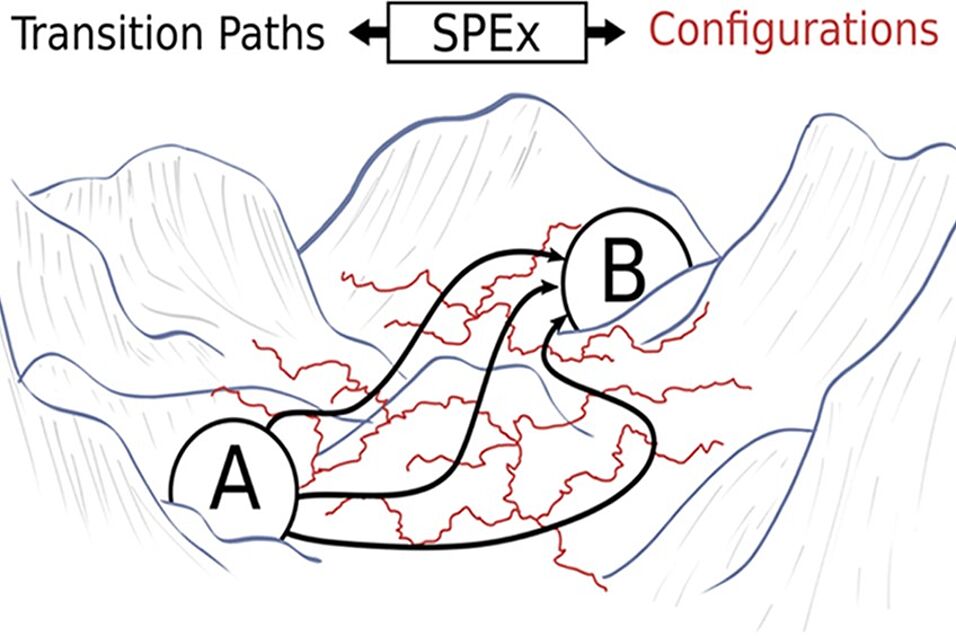This method, called SPEx, significantly reduces the computational cost of such simulations and paves the way for a more efficient investigation of complex processes such as chemical reactions, biomolecular reorganizations, and phase transitions.
Many interesting processes in physics, chemistry, and biology belong to the class of the so-called rare events. Such events occur very rarely but progress quickly when they happen. Classical examples are the conformational change of a protein (aka folding) or the formation of a crystal of ice in supercooled water (aka nucleation) and many more. The disparity between the frequency of these events and their speed makes them a nightmare to simulate on a computer, as most of the computing time is spent just waiting for the event to happen. Moreover, one or a few single realizations of the event under investigation are usually not sufficient to obtain real physical insights into the nature and the detailed mechanism of the process.
Over the years, many approaches have been developed to enhance the computer simulation of such processes, following mainly two strategies: Either by nudging the system toward the barrier separating the stable states or by forcing the simulation to focus on transition paths between these states. The former approach is very efficient, but the dynamics of the process is usually distorted by an artificial bias acting on the system. The latter preserves the dynamics and produces physically accurate transitions but is computationally costly, because full transition paths need to be generated repeatedly.
The SPEx-method now proposed by the Vienna group combines the best of these approaches. Two simulations are performed in parallel: A first simulation is carried out in configuration space, where the system is steered toward regions with a high probability of producing a rare event. A second simulation operates in the space of trajectories, where the system is forced to produce transition paths from so-called shooting points. Then, once in a while, configurations from the first and shooting points from the second simulation are exchanged. In this way, two important objectives are achieved: First, the paths produced are statistically less correlated, as shooting points are obtained from an independent simulation in configuration space. Second, new transition channels in path space are discovered more easily, as the exploration of the space of shooting points is efficiently performed in configuration space via enhanced sampling techniques. The exchange of configurations and shooting points is done randomly but subject to an acceptance criterion that ensures that the correct distribution is sampled. It is because of this exchange of shooting points that the method is called SPEx-Shooting Point Exchange.
In their publication, the Vienna researchers have demonstrated SPEx by using it to investigate the isomerization of a biomolecule with multiple reaction channels and the folding of a small protein. The potential applications of SPEx, however, extend far beyond the specific case studies presented so far.
Due to its versatility and ability to efficiently explore free energy surfaces and ensembles of transition pathways, the method holds the promise to improve our understanding of molecular processes and accelerate research in drug development, biochemistry, and materials science.
The research was supported by the Austrian Science Fund (FWF) through the SFB TACO Grant number F 81-N, with computational results achieved using the Vienna Scientific Cluster (VSC).
Publication: Sebastian Falkner, Alessandro Coretti, and Christoph Dellago, "Enhanced Sampling of Configuration and Path Space in a Generalized Ensemble by Shooting Point Exchange", Physical Review Letters 132, 128001 (2024).
DOI: https://doi.org/10.1103/PhysRevLett.132.128001
Scientific Contact:
Prof. Christoph Dellago
Faculty of Physics
University of Vienna
1090 Wien, Kolingasse 14-16
T +43-1-4277-512 60
M +43-664-602 77-512 60
christoph.dellago@univie.ac.at
http://comp-phys.univie.ac.at

